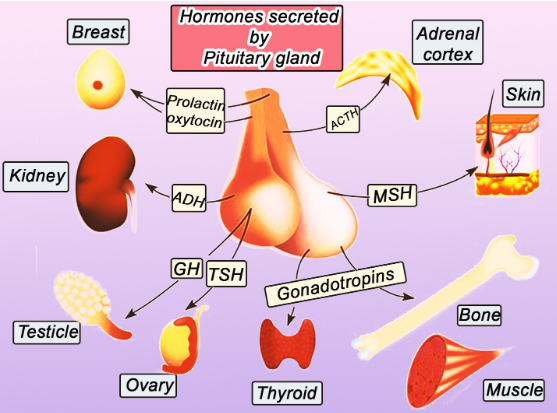
How does control of the anterior and posterior pituitary differ?
Answer
519.6k+ views
Hint: The pituitary gland is known as the “master gland” present in the base of the brain and works in collaboration with the hypothalamus. The hypothalamus collects all the information from the brain and sends it to the pituitary gland. The information received by the pituitary influences the synthesis and release of hormones by the pituitary gland.
Complete answer:
Difference between anterior pituitary and posterior pituitary
Additional information:
-The pituitary gland is known as the master gland because it controls many different activities of the body like it secrete growth hormone, prolactin (activates milk production in lactating women), antidiuretic hormone (helps control body water balance through its effects on kidneys), thyrotropin (stimulate thyroid gland), corticotrophin (stimulates adrenal gland), endorphins (chemicals that act on the nervous system to reduce pain and it also secretes hormones that signal the reproductive organs to synthesize sex hormone.
-The pituitary gland also controls ovulation, menstrual cycle, and uterus contraction during labor in women.

Note:
Endocrine glands are a part of the endocrine system and are also known as ductless glands. These are the glands that secrete hormones directly into the bloodstream and not into tubes or ducts of the body and hence the name Ductless glands. Since they are a part of the endocrine system they are known as endocrine glands. The main endocrine glands include the hypothalamus, pituitary, thyroid, adrenal, parathyroid, pineal body, testes, and ovaries.
Complete answer:
Difference between anterior pituitary and posterior pituitary
| Anterior pituitary | Posterior pituitary |
| The secretion of the anterior pituitary is under the control of the hypothalamus. | The posterior pituitary is completely under the control of the hypothalamus and is also a part of it. |
| They are present in the form of proteins or glycoproteins. | They are simply for the storage of hormones. |
| They include several hormones like luteinizing hormone, growth hormone, thyroid hormone, follicle-stimulating hormone, prolactin. | They include only two hormones that are oxytocin and antidiuretic. |
| It is also known as adenohypophysis. | It is also known as neurohypophysis. |
| They are responsible for the physiological functioning of the body. | They are responsible for the positive feedback in the body. |
Additional information:
-The pituitary gland is known as the master gland because it controls many different activities of the body like it secrete growth hormone, prolactin (activates milk production in lactating women), antidiuretic hormone (helps control body water balance through its effects on kidneys), thyrotropin (stimulate thyroid gland), corticotrophin (stimulates adrenal gland), endorphins (chemicals that act on the nervous system to reduce pain and it also secretes hormones that signal the reproductive organs to synthesize sex hormone.
-The pituitary gland also controls ovulation, menstrual cycle, and uterus contraction during labor in women.

Note:
Endocrine glands are a part of the endocrine system and are also known as ductless glands. These are the glands that secrete hormones directly into the bloodstream and not into tubes or ducts of the body and hence the name Ductless glands. Since they are a part of the endocrine system they are known as endocrine glands. The main endocrine glands include the hypothalamus, pituitary, thyroid, adrenal, parathyroid, pineal body, testes, and ovaries.
Recently Updated Pages
Master Class 12 Business Studies: Engaging Questions & Answers for Success

Master Class 12 Economics: Engaging Questions & Answers for Success

Master Class 12 English: Engaging Questions & Answers for Success

Master Class 12 Maths: Engaging Questions & Answers for Success

Master Class 12 Social Science: Engaging Questions & Answers for Success

Master Class 12 Chemistry: Engaging Questions & Answers for Success

Trending doubts
What is meant by exothermic and endothermic reactions class 11 chemistry CBSE

Which animal has three hearts class 11 biology CBSE

10 examples of friction in our daily life

One Metric ton is equal to kg A 10000 B 1000 C 100 class 11 physics CBSE

1 Quintal is equal to a 110 kg b 10 kg c 100kg d 1000 class 11 physics CBSE

Difference Between Prokaryotic Cells and Eukaryotic Cells




